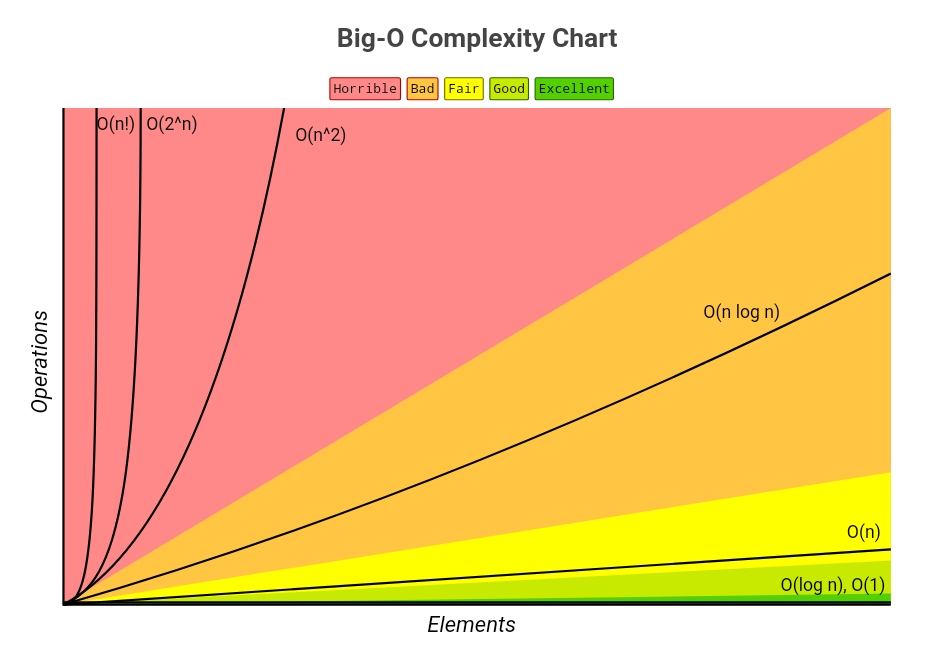Efficiency
Memoization
Remember the results that have been computed before.
The below memo decorator takes in a function and only calls it when the result of f(n) is not found in cache. It only behave the same as f if f is pure.
def memo(f):
cache = {}
def memoized(n):
if n not in cache:
cache[n] = f(n) # Only call f when the result of f(n) is not found
return cache[n]
return memoizedOrders of Growth
The order of growth of a process expresses in simple terms how the resource (computational resources of space and time) requirements of a process grow as a function of the input. Processes can be catagorized according to the order of growth.
A few examples
| Category | Theta Notation | Growth Description | Example | Equation - Left: Time for input - Right: Time for input |
|---|---|---|---|---|
| Constant | $$\Theta,(1)$$ | Growth is independent of the input | absDictionaries | |
| Logarithmic | $$\Theta,(\log n)$$ | Doubling | fast_exp | - Left: Time for $$a\cdot \ln(2\cdot n) = (a\cdot \ln n)+ a\cdot \ln 2$$ |
| Linear | $$\Theta,(n)$$ | Incrementing | exp | $$a\cdot (n+1) = (a\cdot n) + a$$ |
| Quadratic | $$\Theta,(n^2)$$ | Incrementing | one_more | $$a\cdot (n+1)^2 = (a\cdot n^2)+a\cdot(2n+1)$$ |
| Exponential | $$\Theta,(b^n)$$ | Incrementing | fib | $$a\cdot b^{n+1} = (a\cdot b^n)\cdot b$$ |

Example: Exponentiation
This is a simple impementation of exponentiation, which doubles the multiplication when doubled the problem size.
def exp(b, n):
if n == 0:
return 1
else:
return b * exp(b, n-1)This implementation takes Linear time:
- Doubling the input doubles the time
the input takes as much time
One more multiplication lets us double the problem size.
def exp_fast(b, n):
if n == 0:
return 1
elif n % 2 == 0:
return square(exp_fast(b, n//2))
else:
return b * exp_fast(b, n-1)
def square(x):
return x * xThis implementation takes Logarithmic time:
- Doubling the input increases the time by a constant
the input increases the time by only 10 times
Quadratic Time
Functions that process all pairs of values in a sequence of length
e.g.
def overlap(a, b):
count = 0
for item in a:
for other in b:
if item == other:
count += 1
return countExponential Time
Tree-recursive functions can take exponential time.
e.g. non-memorized fib
Order of Growth Notation
Big O Notation
It is defined as upper bound and upper bound on an algorithm is the most amount of time required ( the worst case performance).
Big Theta Notation
It is define as tightest bound and tightest bound is the best of all the worst case times that the algorithm can take.
Space, Memory
In evaluating an expression, the interpreter preserves all active environments and all values and frames referenced by those environments. An environment is active if it provides the evaluation context for some expression being evaluated. An environment becomes inactive whenever the function call for which its first frame was created finally returns.
Python automatically reclaim inactive frames.
>>> def count_frames(f):
def counted(*args):
counted.open_count += 1
counted.max_count = max(counted.max_count, counted.open_count)
result = f(*args)
counted.open_count -= 1
return result
counted.open_count = 0
counted.max_count = 0
return counted
>>> fib = count_frames(fib)
>>> fib(19)
4181
>>> fib.open_count
0
>>> fib.max_count
19
>>> fib(24)
46368
>>> fib.max_count
24To summarize, the space requirement of the fib function, measured in active frames, is one less than the input, which tends to be small. The time requirement measured in total recursive calls is larger than the output, which tends to be huge.